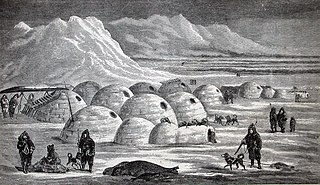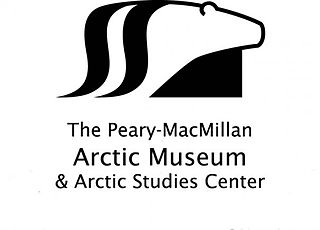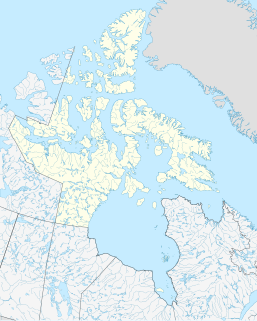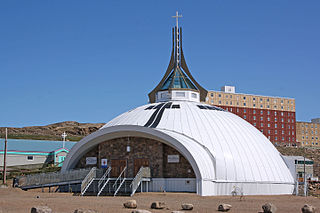 W
WThe Inuit are indigenous people who live in the Arctic and subarctic regions of North America. The ancestors of the present-day Inuit, are culturally related to Iñupiat, and Yupik, and the Aleut who live in the Aleutian Islands of Siberia and Alaska. The term culture of the Inuit, therefore, refers primarily to these areas; however, parallels to other Eskimo groups can also be drawn.
 W
WThe Aboriginal Peoples Television Network is a Canadian specialty channel. Established in 1992 with governmental support to broadcast in Canada's northern territories, since 1999 APTN has had a national broadcast licence. It airs and produces programs made by, for and about Indigenous peoples in Canada and the United States. Based in Winnipeg, Manitoba, it is the first network by and for North American indigenous peoples.
 W
WIndigenous whaling is the hunting of whales by indigenous peoples. It is permitted under international regulation, but in some countries remains a contentious issue. It is usually considered part of the subsistence economy. In some places whaling has been superseded by whale watching instead. This article deals with communities that continue to hunt; details about communities that have ended the practice may be found at History of whaling.
 W
WThe Inuit angakkuq Inuvialuktun: angatkuq; Greenlandic: angakkoq, pl. angákut) is an intellectual and spiritual figure in Inuit culture who corresponds to a medicine man. Other cultures, including Alaska Natives, have traditionally had similar spiritual mediators, although the Alaska Native religion has many forms and variants.
 W
WA burial tree or burial scaffold is a tree or simple structure used for supporting corpses or coffins. They were once common among the Balinese, the Naga people, certain Aboriginal Australians, and some North American First Nations.
 W
WAn Eskimo kiss, nose kiss, or nose rub, is the act of pressing the tip of one's nose against another's nose, usually interpreted as a friendly greeting gesture in various cultures. An actual ‘eskimo kiss’ is called a ‘kunik’ and it is the action of rubbing ones nose against another’s cheek. The more you love or have affection towards that person, the harder you rub.
 W
WAn igloo, also known as a snow house or snow hut, is a type of shelter built of snow, typically built when the snow is suitable.
 W
WInu-Yupiaq is a dance group at the University of Alaska, Fairbanks that performs a fusion of Iñupiaq and Yup’ik Eskimo motion dance.
 W
WInuit astronomy is centered around the Qilak, the Inuit name for the celestial sphere and the home for souls of departed people. Inuit beliefs about astronomy are the shaped by the harsh climate in the Arctic and the resulting difficulties to survive and hunt in the region. The stars were an important tool to track time, seasons, and location, particularly during winter.
 W
WInuit dolls are made out of soapstone and bone, materials common to the people of northern Alaska, Greenland and Northern Canada. Many are clothed with animal fur or skin. Their clothing articulates the traditional style of dress necessary to survive cold winters, wind, and snow. Dolls could have been gifts to young Inuit girls, to be used as teaching devices and passing down of culture. With these dolls, young girls learn various skills necessary for their survival such as skin preparation, cutting & sewing, proper use of materials, designs and significance of symbols in their cultures. Inuit dolls were enjoyed by both young and old Inuit individuals and give an excellent insight into Inuit culture.
 W
WThe Inuit languages are a closely related group of indigenous American languages traditionally spoken across the North American Arctic and to some extent in the subarctic in Labrador. The related Yupik languages are spoken in western and southern Alaska and in the far east of Russia, but are severely endangered in Russia today and spoken only in a few villages on the Chukchi Peninsula. The Inuit live primarily in three countries: Greenland, Canada, and the United States.
 W
WInuit weapons were primarily hunting tools which served a dual purpose as weapons, whether against other Inuit groups or against their traditional enemies, the Chipewyan, Tłı̨chǫ (Dogrib), Dene, and Cree.
 W
WThe Inuit are indigenous people who live in the Arctic and subarctic regions of North America. The ancestors of the present-day Inuit, are culturally related to Iñupiat, and Yupik, and the Aleut who live in the Aleutian Islands of Siberia and Alaska. The word "Eskimo" has been used to encompass the Inuit and Yupik, and other indigenous Alaskan and Siberian peoples, but this usage is in decline.
 W
WAn inuksuk or inukshuk is a manmade stone landmark or cairn built for use by the Inuit, Iñupiat, Kalaallit, Yupik, and other peoples of the Arctic region of North America. These structures are found in northern Canada, Greenland, and Alaska. This combined region, north of the Arctic Circle, is dominated by the tundra biome and has areas with few natural landmarks.
 W
WInuksuk Point is a small peninsula on Foxe Peninsula, approximately 88.5 km (55.0 mi) from Kinngait on the southwest of Baffin Island in Nunavut, Canada.
 W
WMasks among Eskimo peoples served a variety of functions. Masks were made out of driftwood, animal skins, bones and feathers. They were often painted using bright colors. There are archeological miniature maskettes made of walrus ivory, dating from early Paleo-Eskimo and from early Dorset culture period.
 W
WNalukataq is the spring whaling festival of the Iñupiat of Northern Alaska, especially the North Slope Borough. It is characterized by its namesake, the dramatic Eskimo blanket toss. "Marking the end of the spring whaling season," Nalukataq creates, "a sense of being for the entire community and for all who want a little muktuk or to take part in the blanket toss....At no time, however, does Nalukataq relinquish its original purpose, which is to recognize the annual success and prowess of each umialik, or whaling crew captain....Nalukataq [traditions] have always reflected the process of survival inherent in sharing...crucial to...the Arctic."
 W
WThe Peary–MacMillan Arctic Museum is a museum located in Hubbard Hall at Bowdoin College in Brunswick, Maine. Named after Arctic explorers and Bowdoin College graduates Robert E. Peary and Donald B. MacMillan, it is the only museum in the lower 48 states of the United States dedicated completely to Arctic Studies.
 W
WPisissarfik is a 1,220-metre-high (4,000 ft) mountain in the Sermersooq municipality, West Greenland. The mountain plays a major role in the Inuit mythology of Pisissarfik. It is also important as an archaeological site.
 W
WPort Refuge is located off the south coast of Grinnell Peninsula in a small bay on the south coast of Devon Island in Nunavut, Canada. The site received its current name by Sir Edward Belcher when he sought refuge there in 1852-1853 from moving ice during his voyage in search of the missing Franklin Expedition.
 W
WQargi, Qasgi or Qasgiq, Qaygiq, Kashim, Kariyit, a traditional large semi-subterranean men's community house' of the Yup'ik and Inuit, also Deg Hit'an Athabaskans, was used for public and ceremonial occasions and as a men’s residence. The Qargi was the place where men built their boats, repaired their equipment, took sweat baths, educated young boys, and hosted community dances. Here people learned their oral history, songs and chants. Young boys and men learned to make tools and weapons while they listened to the traditions of their forefathers.
 W
WQarmaq is an Inuktitut term for a type of inter-seasonal, single-room family dwelling used by Inuit. To the Central Inuit of Northern Canada, it refers to a hybrid of a tent and igloo, or tent and sod house. Depending on the season, the lower portion was constructed of snow blocks or stone, while the upper portion used skins or canvas. To the Kalaallit of Greenland, qarmaq refers to the dwelling's wall. Qarmaq were built in the transitional seasons of fall and spring with a circular wall of stone, sod, or blocks of snow, a framework usually made from animal bones, which were covered with a skin.
 W
WQiviuq [sg] or qiviut [pl] is the inner wool of the muskox. In Inuktitut the same word can be used to refer to the down feathers of birds.
 W
WSt. Jude's Cathedral is the Anglican cathedral in Iqaluit, Nunavut, Canada. The cathedral is the seat of the Diocese of The Arctic, which covers the Northwest Territories, Nunavut, and the Nunavik region of Northern Quebec. It has the greatest area of any Anglican diocese in the world. The cathedral is also the parish church for the parish of Iqaluit and holds services in English and Inuktitut.
 W
WThe Savage Innocents is a 1960 adventure film directed and co-written by Nicholas Ray. Anthony Quinn and Yoko Tani star, with Lee Montague, Marco Guglielmi, Carlo Giustini, Anthony Chinn, and Michael Chow in supporting roles, alongside Peter O' Toole in his film debut. It was adapted from the novel Top of the World by Swiss writer Hans Rüesch.
 W
WSubsistence hunting of the bowhead whale is permitted by the International Whaling Commission, under limited conditions. While whaling is banned in most parts of the world, some of the Native peoples of North America, including the Eskimo and Iñupiat peoples in Alaska, continue to hunt the Bowhead whale. Aboriginal whaling is valued for its contribution to food stocks and to cultural survival, although the days of commercial whaling in the United States and in Canada are over.
 W
WThe tupiq is a traditional Inuit tent made from seal or caribou skin. An Inuk was required to kill five to ten ugjuk to make a sealskin tent. When a man went hunting he would bring a small tent made out of five ugjuit. A family tent would be made of ten or more ugjuit.